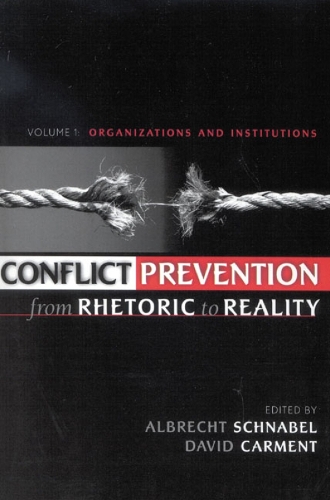
Conflict Prevention from Rhetoric to Reality: Organizations and Institutions
(Paperback)
Publishing Details
Conflict Prevention from Rhetoric to Reality: Organizations and Institutions
By (Author) Albrecht Schnabel
Edited by David Carment
Contributions by Medardo C. Abad
Contributions by Rafis Abazov
Contributions by Shahram Akbarzadeh
Contributions by Annika Bjrkdahl
Contributions by Fraser Cameron
Contributions by A Walter Dorn
Contributions by Colleen Duggan
Contributions by Charles Dufresne
Bloomsbury Publishing PLC
Lexington Books
2nd July 2004
United States
Classifications
General
Non Fiction
Politics and government
303.69
Physical Properties
Paperback
400
Width 232mm, Height 225mm, Spine 34mm
662g
Description
Together with local actors, many governments, regional organizations and the UN are embracing preventive action as a viable path towards sustainable peace. The contributions to this volume trace conflict prevention efforts in various regional contexts and explain how preventive thinking is being successfully mainstreamed into the activities of regional organizations and the UN.
Reviews
These two volumes form an encyclopedic study of the means of conflict prevention. The first volume examines agents and institutions, the second causes and capacities. The choice of chapters to encompass the components of the subject is careful and comprehensive, and there is much bredth and wisdom in the chapters themselves. The volumes deserve a wide and bifocal audience. For analysts, the two volumes push back the frontiers into new aspects to study; for practitioners, they show that the challenge is in applying what we know aplenty, not in hiding behind claims of ignorance... -- I. William Zartman, The Paul H. Nitze School of Advanced International Studies, Johns Hopkins University
It is always a pleasure to come across volumes with the breadth and scope as the ones edited so perceptively by David Carment and Albrecht Schnabel. Their gumption illuminates the patterns of mainstreaming conflict prevention in the post-Cold War period. In this respect, these tomes are not simply a reassessment of extant analytical frameworks, but an inspiring mapping of politics and policy of conflict prevention. Thence, the two parts of Conflict Prevention are a lasting testimony of the encyclopedic endeavor to chart the gist of different conflict prevention approaches, while presenting a cornucopia of insight and best-practice. * Panorama *
The scholarship is first-rate, thorough, and comprehensive. This work will be a significant contribution to the study, training and practice of conflict prevention. . . . Overall the original evidence, comprehensiveness, and integrative nature of the work are its best features. -- Franke Wilmer, Director and Professor, Political Science, Montana State University, Bozeman, , Director and Professor, Political Science, Montana State University, Bozeman
These two volumes form an encyclopedic study of the means of conflict prevention. The first volume examines agents and institutions, the second causes and capacities. The choice of chapters to encompass the components of the subject is careful and comprehensive, and there is much bredth and wisdom in the chapters themselves. The volumes deserve a wide and bifocal audience. For analysts, the two volumes push back the frontiers into new aspects to study; for practitioners, they show that
the challenge is in applying what we know aplenty, not in hiding behind claims of ignorance.
Author Bio
Albrecht Schnabel is senior research fellow at swisspeace, Bern. David Carment is director of the Centre for Security and Defense Studies and associate professor of international affairs at Carleton University, Ottawa.
